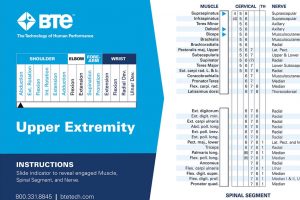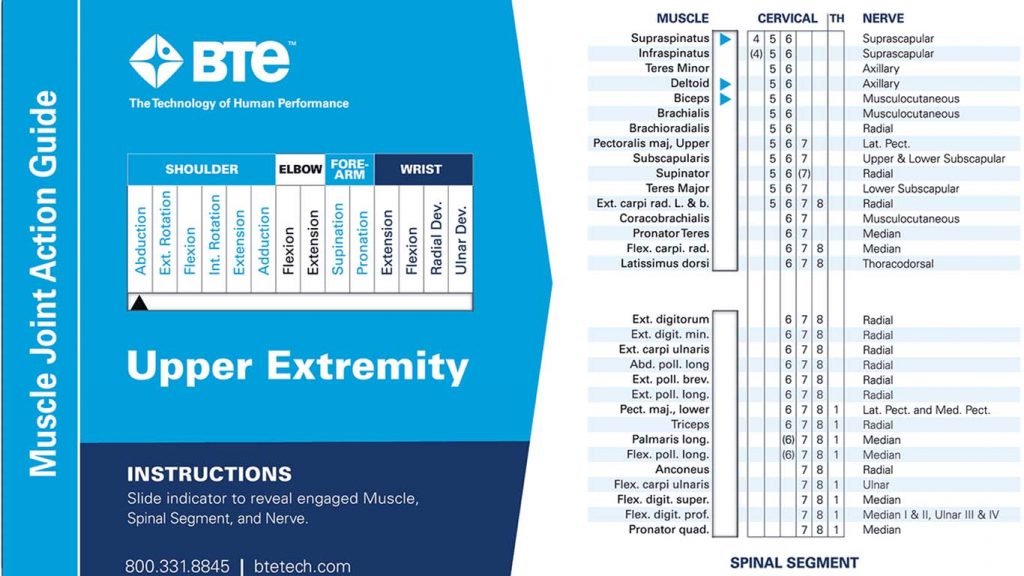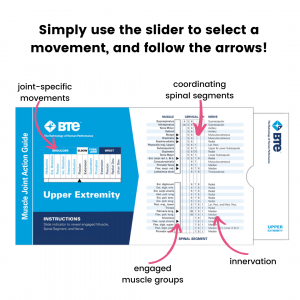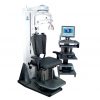
Ditch the Anatomy Charts – Your One-stop Guide to Joint Movements, Muscle Groups, and Innervation
Treatment GuidelinesFaster than you could search it online, this hand-held tool shows you the activated muscle groups, spinal segment, and innervation for 26 different joint-specific movements, both upper and lower extremity.
Get the MJAG – quick and easy joint movement and innervation reference tool

You kept your extremely expensive and heavy anatomy book from that dreaded class years ago, right? And you review it every day to brush up on joint movement and innervation. And, on the very off-chance that you might forget something like what nerve innervates the coracobrachialis during shoulder adduction, you’d whip out that trusty (and probably dusty) anatomy textbook in the clinic… right?
How else are you supposed to remember every one of the 37 muscles, 10 nerves, and five spinal segments involved in lower extremity joint movements? And how about the 31 other muscles, 10 different nerves and six spinal segments that activate the upper extremities?
We’ll forgive you if you can’t always remember every detail of the 26 possible joint and muscle movements. In fact, we’ll give you a tool that does all the remembering for you. BTE’s Muscle Joint Action Guide (MJAG) is the quick reference tool that no mere mortal clinician should be without. Faster than you could search it online, this hand-held tool shows you the activated muscle groups, spinal segment, and innervation for 26 different joint-specific movements, both upper and lower extremity.
Joint-specific movements and anatomy
Let’s say you specialize in one type of therapy, but you still occasionally treat others. Some of those less frequent anatomical names begin to fade away. It’s only human to begin forgetting information you haven’t used in a while. Here’s a quick check to see if you could benefit from the MJAG. Can you answer all of the following questions from memory?
- What nerve innervates the coracobrachialis during shoulder adduction?
- Which four muscles are involved when you dorsiflex your ankle?
- How many muscles are involved with the simple motion of elbow flexion?
- What motion occurs when the sciatic nerve activates the biceps long head and short head?
If you answered all those, congrats! Your anatomy professor is somewhere out there wiping away a single tear of joy. For the rest of us, the quick and easy Muscle Joint Action Guide is the last anatomy reference tool you’ll need.
Muscle group, innervation, and nerve damage
It’s not just for recalling anatomical terms. The MJAG can also help you recognize and treat nerve damage. For example, your patient shows extreme weakness performing a certain muscle movement, use the cheat sheet to see which nerve controls it. And it works the other way around. If a patient walks in with diagnosed nerve damage, the Muscle Joint Action Guide will show you which muscle groups and joint-specific movements it affects. This information alone could show you a starting point in your treatment plan.
How the MJAG works

Just slide the insert to select a joint movement, like Elbow Flexion. And right there, you’ll see the activated muscle group, specific spinal segment location, and controlling nerve. It’s that easy. With a quick and easy slide, you’ll get detailed anatomical information for 26 different joint-specific movements, both upper and lower extremity. The Muscle Joint Action Guide is your one-stop reference for joint-specific muscle movements, muscle group, spinal segments, and innervation.
Answers
1) musculocutaneous
2) tibialis anterior, extensor digitorum longus, peroneus tertius, and extensor hallucis longus
3) eight muscles
4) knee lateral rotation
John Vermette
BTE
Director of Provider and Product Management




